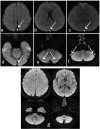Role of diffusion-weighted imaging in the diagnosis of cerebral venous thrombosis
- PMID: 32589072
- PMCID: PMC7323280
- DOI: 10.1177/0300060520933448
Role of diffusion-weighted imaging in the diagnosis of cerebral venous thrombosis
Abstract
Objective: To evaluate the hyperintense signal (HIS) performance on diffusion-weighted imaging (DWI) in diagnosing cerebral venous thrombosis (CVT).
Methods: Seventy-eight patients with CVT hospitalized from January 2004 to January 2015 were retrospectively studied alongside 78 controls without intracranial organic diseases. Diagnostic accuracy indices of HIS on DWI or T2-weighted imaging (T2WI) to diagnose CVT at different sites and states were analyzed.
Results: The overall sensitivity of HIS on DWI for the diagnosis of CVT was significantly lower than that of HIS on T2WI (34.6% vs. 79.5%). HIS on T2WI was more sensitive than HIS on DWI in detecting thrombosis, especially in the superior sagittal sinus and transverse sinus. HIS on DWI was inversely related to the time between disease onset and imaging. Compared with HIS on T2WI, combining HIS on DWI and T2WI did not increase the sensitivity for detecting CVT. HIS on DWI was not detected in the control group, but HIS on T2WI was detected in 26.3% of control individuals. The specificity of HIS on DWI for CVT was higher than that of HIS on T2WI (97.4% vs. 76.9%).
Conclusion: HIS on DWI has a lower sensitivity, but a higher specificity, than HIS on T2WI for diagnosing CVT.
Keywords: Cerebral venous thrombosis; T2-weighted imaging; diagnostic sensitivity; diagnostic specificity; diffusion-weighted imaging; hyperintense signal; magnetic resonance imaging.
Figures



Similar articles
-
Diffusion-Weighted Magnetic Resonance Imaging in the Diagnosis of Cerebral Venous Thrombosis : A Meta-Analysis.J Korean Neurosurg Soc. 2021 May;64(3):418-426. doi: 10.3340/jkns.2020.0247. Epub 2021 Apr 30. J Korean Neurosurg Soc. 2021. PMID: 33993690 Free PMC article.
-
[Combined T2-weighted and diffusion-weighted MR imaging for staging of rectal cancers].Zhonghua Zhong Liu Za Zhi. 2018 Jan 23;40(1):46-51. doi: 10.3760/cma.j.issn.0253-3766.2018.01.008. Zhonghua Zhong Liu Za Zhi. 2018. PMID: 29365417 Chinese.
-
Diffusion-Weighted MR Imaging Findings of Cortical Vein Thrombosis at 3 T.Clin Neuroradiol. 2015 Sep;25(3):249-56. doi: 10.1007/s00062-014-0301-y. Epub 2014 Apr 5. Clin Neuroradiol. 2015. PMID: 24705990
-
Imaging of cerebral venous thrombosis.Diagn Interv Imaging. 2014 Dec;95(12):1145-50. doi: 10.1016/j.diii.2014.10.006. Epub 2014 Nov 24. Diagn Interv Imaging. 2014. PMID: 25465119 Review.
-
The diagnostic efficiency of diffusion-weighted imaging in placenta accreta spectrum: a systematic review and meta-analysis.Eur Rev Med Pharmacol Sci. 2024 Jan;28(1):49-58. doi: 10.26355/eurrev_202401_34890. Eur Rev Med Pharmacol Sci. 2024. PMID: 38235857
Cited by
-
Imaging of Cerebral Venous Thrombosis.Life (Basel). 2022 Aug 10;12(8):1215. doi: 10.3390/life12081215. Life (Basel). 2022. PMID: 36013394 Free PMC article. Review.
-
Acute T2*-Weighted Magnetic Resonance Imaging Detectable Cerebral Thrombosis in a Rat Model of Subarachnoid Hemorrhage.Transl Stroke Res. 2022 Feb;13(1):188-196. doi: 10.1007/s12975-021-00918-0. Epub 2021 Jun 2. Transl Stroke Res. 2022. PMID: 34076826 Free PMC article.
-
Diffusion-Weighted Magnetic Resonance Imaging in the Diagnosis of Cerebral Venous Thrombosis : A Meta-Analysis.J Korean Neurosurg Soc. 2021 May;64(3):418-426. doi: 10.3340/jkns.2020.0247. Epub 2021 Apr 30. J Korean Neurosurg Soc. 2021. PMID: 33993690 Free PMC article.
-
Comparison of susceptibility-weighted angiography (SWAN) and T2 gradient-echo sequences for the detection of acute cerebral venous thrombosis.Neuroradiol J. 2023 Apr;36(2):148-157. doi: 10.1177/19714009221109885. Epub 2022 Jun 18. Neuroradiol J. 2023. PMID: 35722681 Free PMC article.
References
-
- Stam J. Thrombosis of the cerebral veins and sinuses. N Eng J Med 2005; 353: 314–315. - PubMed
-
- Saposnik G, Barinagarrementeria F, Brown RD, et al. Diagnosis and management of cerebral venous thrombosis a statement for healthcare professionals from the American Heart Association/American Stroke Association. Stroke 2011; 42: 1158. - PubMed
-
- Corvol JC, Oppenheim C, Manai R, et al. Diffusion-weighted magnetic resonance imaging in a case of cerebral venous thrombosis. Stroke 1998; 29: 2649–2652. - PubMed
MeSH terms
LinkOut - more resources
Full Text Sources
Medical

